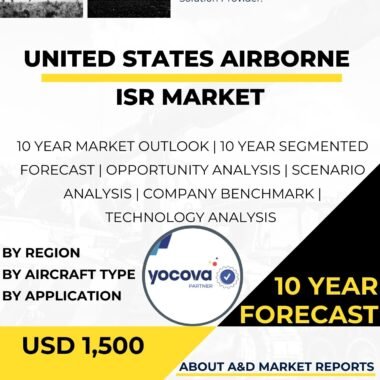Description
Canada Airborne ISR Market
The Canada Airborne Intelligence, Surveillance, and Reconnaissance (ISR) market play a crucial role in enhancing the Canadian Armed Forces’ ability to gather critical information, monitor activities, and maintain situational awareness across vast areas of interest. Airborne ISR capabilities encompass a wide range of aircraft, sensors, and technologies designed to provide real-time and actionable intelligence to support defense operations, national security, and humanitarian efforts. Canada’s commitment to airborne ISR stems from its need to monitor and secure extensive airspace, vast maritime borders, and remote territories. The nation’s strategic geographical location and international obligations necessitate a robust airborne ISR capability to address emerging threats, respond to emergencies, and contribute to global security. One of the primary assets in the Canada Airborne ISR market is the use of specialized aircraft equipped with advanced sensors and intelligence-gathering systems. These aircraft, such as the CP-140 Aurora and the CP-140M Arcturus, are specifically configured for ISR missions and are capable of conducting a variety of surveillance tasks, including maritime patrol, anti-submarine warfare, and search and rescue.
The CP-140 Aurora, for instance, serves as Canada’s primary long-range maritime patrol aircraft, equipped with powerful radar, electronic warfare systems, and an array of sensors to detect, track, and identify surface vessels and submarines. The CP-140M Arcturus, on the other hand, provides a tactical maritime patrol capability, supporting the Royal Canadian Navy’s operations and contributing to coastal security.
In addition to dedicated ISR aircraft, Canada also utilizes intelligence-gathering capabilities on various other platforms. Unmanned Aerial Vehicles (UAVs) or drones play a significant role in providing persistent surveillance and reconnaissance capabilities over remote or challenging terrains. These UAVs, such as the RQ-21 Blackjack and the ScanEagle, can be deployed for ISR missions in both military and civilian applications, supporting border patrol, environmental monitoring, and disaster response efforts.
The success of airborne ISR missions relies on advanced sensor technology. Canada invests in state-of-the-art radar, electro-optical/infrared (EO/IR) cameras, signals intelligence (SIGINT) systems, and other specialized sensors to optimize the collection and analysis of intelligence data.
The integration of sophisticated sensor systems on airborne platforms enables real-time data transmission to ground-based command centers, enhancing decision-making capabilities and facilitating timely responses to emerging threats or operational requirements.
Moreover, Canada’s airborne ISR market also includes advanced communication systems that ensure seamless data sharing and information exchange between ISR aircraft and ground-based units. Reliable and secure communications are vital for maintaining continuous situational awareness and supporting coordination among different military branches and agencies.
The Canada Airborne ISR market is subject to continuous advancements and upgrades. Research and development efforts focus on improving sensor capabilities, increasing aircraft endurance, and optimizing data processing and exploitation. The objective is to enhance the overall effectiveness and efficiency of airborne ISR missions.
Furthermore, collaboration with domestic and international defense industry partners is vital to driving innovation in the airborne ISR market. Public-private partnerships facilitate technology transfer, knowledge sharing, and the integration of cutting-edge solutions into Canada’s ISR capabilities.
Canada’s airborne ISR capabilities are not limited to military applications; they also play a significant role in supporting civilian authorities and addressing national security challenges. In disaster response scenarios, airborne ISR platforms provide crucial situational awareness, aiding in the coordination of rescue and relief efforts.
The integration of airborne ISR systems with other intelligence sources, such as satellite imagery and ground-based sensors, enables comprehensive information gathering and analysis. This multi-source approach enhances the accuracy and reliability of intelligence data and contributes to a more comprehensive understanding of security threats and operational environments.
Canada’s commitment to airborne ISR extends beyond its territorial borders. The Canadian Armed Forces actively contribute to international peacekeeping and security efforts, providing ISR support to multinational missions. Participation in such operations strengthens defense cooperation with allied nations and contributes to global security and stability.
In addition to military applications, Canada’s airborne ISR capabilities also support law enforcement agencies and civil authorities in addressing various security challenges, such as border surveillance, drug trafficking, and environmental monitoring. The versatility of airborne ISR assets makes them valuable tools for supporting civilian missions.
Moreover, the effective use of airborne ISR requires well-trained personnel and a robust command and control infrastructure. The Canadian Armed Forces conduct regular training exercises and simulation-based drills to ensure that operators and analysts are proficient in utilizing ISR systems and interpreting intelligence data accurately.
In conclusion, the Canada Airborne ISR market plays a pivotal role in enhancing the nation’s defense capabilities, ensuring airspace security, and supporting national security objectives. Through specialized aircraft, advanced sensor technology, and sophisticated communication systems, Canada’s airborne ISR assets provide critical intelligence, surveillance, and reconnaissance capabilities.
These capabilities are essential for monitoring vast areas of interest, conducting maritime patrols, and responding to emerging threats and emergencies. The integration of airborne ISR with other intelligence sources and international cooperation enhances Canada’s ability to address security challenges both domestically and on the global stage.
Ongoing investment in research and development, collaboration with defense industry partners, and continuous training of personnel ensure that Canada remains at the forefront of airborne ISR capabilities. As the nature of security threats continues to evolve, Canada’s commitment to airborne ISR ensures its ability to adapt to emerging challenges and maintain a strong defense posture in the dynamic and complex operational environments of the modern era.




